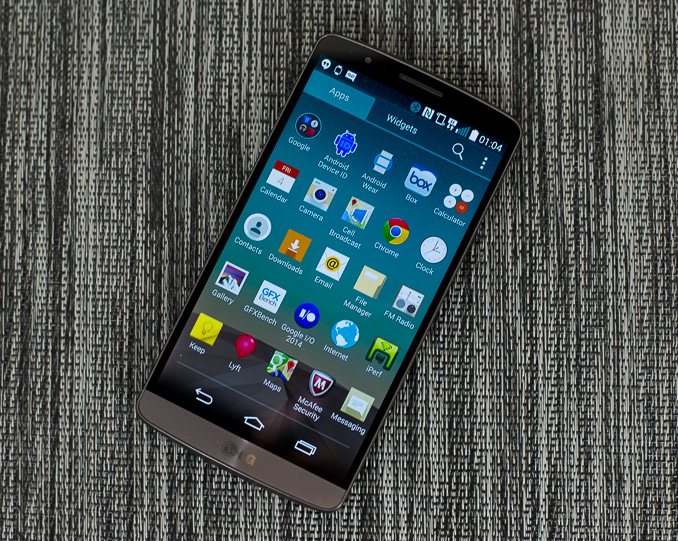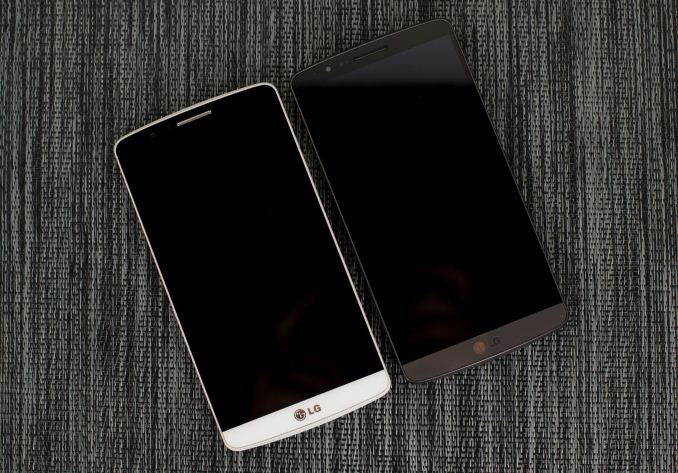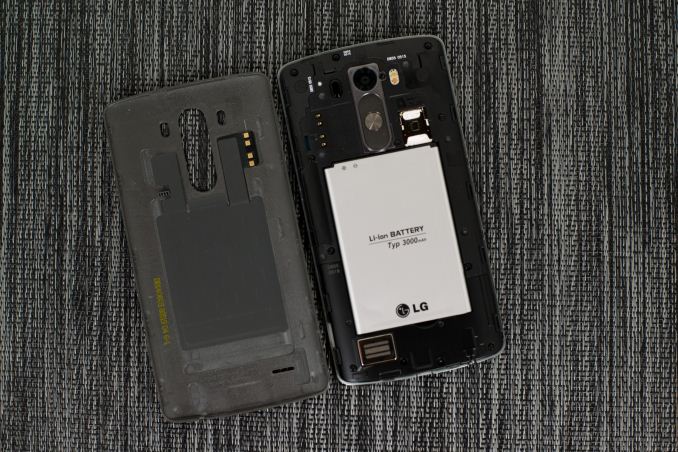The LG G3 Review
by Joshua Ho & Anand Lal Shimpi on July 4, 2014 5:00 AM EST- Posted in
- Smartphones
- LG
- Mobile
- Laptops
- G3

While the enthusiast segment is no stranger to LG smartphones, for the most part LG hasn’t received nearly the amount of attention that Samsung has. At first, it doesn’t make much sense. After all, LG is almost as big as Samsung. Both are chaebols, with enormous resources and power that few other companies have. Starting from the Optimus G, it seems that LG has shipped some of the best hardware in the industry, leveraging all the branches of the company from LG Innotek to LG Display to make a product that was easily equal to or better than the competition at the time.
One of the real issues that LG faced was a credibility gap. After the Optimus 2X and 4X HD, LG simply lacked credibility amongst the enthusiast audience. Without this audience and without the marketing push that other OEMs had, LG phones simply didn’t sell. Fortunately, things have gotten better since those days. The G2 brought significant attention to LG phones, and if anything, LG has been the sleeping giant in the industry. LG’s displays have been some of the best in the industry, and as an Android OEM they’ve consistently executed well on hardware. The immense popularity of the LG-made Nexus 4 and 5, even amongst mainstream consumers is surprising, especially because they were supposed to be developer devices.
Hardware
This leads us to the LG G3, which is now available in Korea and ready to be sold internationally. LG now faces the difficult task of succeeding the G2, one of the best phones of 2013. To find out whether they’ve made a worthy successor, we start with industrial and material design. When you first pick up the G3, it’s obvious that LG wanted to make a phone with the look and feel of brushed aluminum. To this end, LG has definitely done a good job. Although the polycarbonate back feels much warmer in the hand, the texture is good, and in practice even after extended use I never felt like the phone was grimy. It’s good to see that most of these OEMs are moving away from glossy finishes. The back cover is also removable, which allows for a removable battery and microSD slot. The front of the display is almost unchanged from last year, with extremely small bezels all around to reduce wasted space. The one change to the front of the phone is a band of color around the bottom that matches the color of the back.
Around the sides, the port layout remains nearly identical. The top has the IR Tx/Rx ports, the bottom has the 3.5mm jack and a microUSB port in the USB 2.0 shape. LG has also added a beveled edge from the display to the sides, which emphasizes the curved nature of the back. On the back of the phone, one can see the camera with the IR rangefinder and LED flash to the sides. The volume and power buttons are directly below the camera. The volume rocker is relatively flat compared to the protruding power button, which also has a noticeably different texture to distinguish the two from each other. The single, 1W speaker is towards the bottom.
Outside of these basic button and port placements, the hardware itself is high-end. The key differentiation points in this case are the camera system, QHD display, and the high-power speaker. I’ve put the rest of the basic specs in the table below.
| LG G3 | |
| SoC | MSM8974AC 2.45 GHz Snapdragon 801 |
| RAM/NAND | 3 GB LPDDR3, 32GB NAND + microSD |
| Display | 5.5” 1440p IPS LCD |
| Network | 2G / 3G / 4G LTE (Qualcomm MDM9x25 UE Category 4 LTE) |
| Dimensions | 146.3 x 74.6 x 8.9mm, 149 grams |
| Camera | 13MP rear camera, 1.12 µm pixels, 1/3.06" CMOS size, F/2.4. 2.1MP F/2.0 FFC |
| Battery | 3000 mAh (11.4 Whr) |
| OS | Android 4.4.2 with LG UI |
| Connectivity | 802.11a/b/g/n/ac + BT 4.0, USB2.0, GPS/GNSS, MHL, DLNA, NFC |
| SIM Size | MicroSIM |
While the spec sheet gives an idea of what to expect from the G3’s size, it’s surprisingly small for a 5.5” display size device. Unfortunately, this doesn’t make the G3 easy to use with one hand. While using the One (M8) and Galaxy S5 with one hand is uncomfortable, the G3 is almost impossible to use with one hand. Trying to tap something on the left side of the phone when using it with the right hand is difficult, and trying to reach for something on the top left of the display is almost impossible. While the division between phone and phablet is relatively clear in my mind, the G3 is in the line between both. I don’t object to the phablet formfactor, but this is supposed to be a phone, not a phablet. In addition, because the G3 has such thin bezels, it's very easy to accidentally activate the touch panel unintentionally while trying to stretch for one area of the display.
Other than the size, I definitely like what LG has done here. The design of the phone is understated and classy, even if it’s a bit off-putting that LG is trying to make plastic feel like metal. The back buttons are a non-issue, even without KnockOn/Off and KnockCode, and the curved back is great for ergonomics. However, I question the wisdom of moving to a removable battery/back cover in this case, as it means that there’s no stacked battery that we saw in the LG G2 and reduces volumetric efficiency. LG has included a curved battery in the G3, although in practice the curve isn't as aggressive as the one we've seen on the G2.













174 Comments
View All Comments
Rdmkr - Friday, July 4, 2014 - link
The concluding statements gave me a laugh; I agree that everything about this phone is perfect except what distinguishes it from the LG G2. If they just made an incremental update of that model they'd be exactly where they need to be. Which kinda raises the question of why they don't just do that. The way smartphone OEMs rigidly classify and offer their models without them ever changing has never been something I well understood.MonkeyPaw - Friday, July 4, 2014 - link
You need some Lumia phones in your camera tests. The 1020 and the 930 might be a nice start.BPB - Friday, July 4, 2014 - link
Agreed!MonkeyPaw - Friday, July 4, 2014 - link
Can't say I've ever seen a Lumia (or WP device) review on Anandtech, save the 521. As unique as the 1020 was, all we saw was a "hands on" at a press event. A little more coverage would be nice.webby7 - Friday, July 4, 2014 - link
So, are we still pretending your senior smartphone editor has dropped off the face of the planet?The lack of information on this is really poor form.
Anand Lal Shimpi - Friday, July 4, 2014 - link
If there was something I could share I would :)cylemmulo - Friday, July 4, 2014 - link
Any phone that resolution, even like a 7 inch tablet serves no purpose except to trick people into buying the phone and eat battery life. Leave me at 720p and give me my battery life back.cmdrdredd - Saturday, July 5, 2014 - link
720p isn't enough, it's gotta be 1080p because yes, I notice differences when watching 1080p videos.phoenix_rizzen - Friday, July 11, 2014 - link
LG Optimus G has a 4.7", 720p screen, and a 2100 mAh battery, weighing only 145g.LG G2 has a 5.2", 1080p screen, a 3000 mAh battery, weighing slightly less (143g), and is only just barely larger than the OG.
OG: 131.9 x 68.9 x 8.5 mm
G2: 138.5 x 70.9 x 8.9 mm
Yet, battery life on the G2 is phenomenal compared to the OG (or, really, any other phone out there). People routinely get 6+ hours of screen-on time, even with the default LG version of Android. And plenty of people can push that to 10+. Personally, I've only ever topped 7 hours, but it's an almost daily occurence now (Mahdi ROM, based on Android 4.4.4, with ART enabled).
There's more to a solid performing, long lasting phone than just the screen. :)
However, I (personally) don't see a reason to go above ~5 inches and 1080p on a phone. For a tablet (7"+), sure. The 2012 Nexus 7 has a horrible screen resolution for the size, although the SoC really limits the choices in resolution. :)
The LG G2 is just about perfect. If only it had a slide-out keyboard ... :(
dwade123 - Friday, July 4, 2014 - link
Android is so damn ugly. Hire some actual designers.